
[The article below is reprinted from the April 1997 edition of The International TNDM Newsletter.]
Air Model Historical Data Study
by Col. Joseph A. Bulger, Jr., USAF, Ret
The Air Model Historical Study (AMHS) was designed to lead to the development of an air campaign model for use by the Air Command and Staff College (ACSC). This model, never completed, became known as the Dupuy Air Campaign Model (DACM). It was a team effort led by Trevor N. Dupuy and included the active participation of Lt. Col. Joseph Bulger, Gen. Nicholas Krawciw, Chris Lawrence, Dave Bongard, Robert Schmaltz, Robert Shaw, Dr. James Taylor, John Kettelle, Dr. George Daoust and Louis Zocchi, among others. After Dupuy’s death, I took over as the project manager.
At the first meeting of the team Dupuy assembled for the study, it became clear that this effort would be a serious challenge. In his own style, Dupuy was careful to provide essential guidance while, at the same time, cultivating a broad investigative approach to the unique demands of modeling for air combat. It would have been no surprise if the initial guidance established a focus on the analytical approach, level of aggregation, and overall philosophy of the QJM [Quantified Judgement Model] and TNDM [Tactical Numerical Deterministic Model]. It was clear that Trevor had no intention of steering the study into an air combat modeling methodology based directly on QJM/TNDM. To the contrary, he insisted on a rigorous derivation of the factors that would permit the final choice of model methodology.
At the time of Dupuy’s death in June 1995, the Air Model Historical Data Study had reached a point where a major decision was needed. The early months of the study had been devoted to developing a consensus among the TDI team members with respect to the factors that needed to be included in the model. The discussions tended to highlight three areas of particular interest—factors that had been included in models currently in use, the limitations of these models, and the need for new factors (and relationships) peculiar to the properties and dynamics of the air campaign. Team members formulated a family of relationships and factors, but the model architecture itself was not investigated beyond the surface considerations.
Despite substantial contributions from team members, including analytical demonstrations of selected factors and air combat relationships, no consensus had been achieved. On the contrary, there was a growing sense of need to abandon traditional modeling approaches in favor of a new application of the “Dupuy Method” based on a solid body of air combat data from WWII.
The Dupuy approach to modeling land combat relied heavily on the ratio of force strengths (largely determined by firepower as modified by other factors). After almost a year of investigations by the AMHDS team, it was beginning to appear that air combat differed in a fundamental way from ground combat. The essence of the difference is that in air combat, the outcome of the maneuver battle for platform position must be determined before the firepower relationships may be brought to bear on the battle outcome.
At the time of Dupuy’s death, it was apparent that if the study contract was to yield a meaningful product, an immediate choice of analysis thrust was required. Shortly prior to Dupuy’s death, I and other members of the TDI team recommended that we adopt the overall approach, level of aggregation, and analytical complexity that had characterized Dupuy’s models of land combat. We also agreed on the time-sequenced predominance of the maneuver phase of air combat. When I was asked to take the analytical lead for the contact in Dupuy’s absence, I was reasonably confident that there was overall agreement.
In view of the time available to prepare a deliverable product, it was decided to prepare a model using the air combat data we had been evaluating up to that point—June 1995. Fortunately, Robert Shaw had developed a set of preliminary analysis relationships that could be used in an initial assessment of the maneuver/firepower relationship. In view of the analytical, logistic, contractual, and time factors discussed, we decided to complete the contract effort based on the following analytical thrust:
- The contract deliverable would be based on the maneuver/firepower analysis approach as currently formulated in Robert Shaw’s performance equations;
- A spreadsheet formulation of outcomes for selected (Battle of Britain) engagements would be presented to the customer in August 1995;
- To the extent practical, a working model would be provided to the customer with suggestions for further development.
During the following six weeks, the demonstration model was constructed. The model (programmed for a Lotus 1-2-3 style spreadsheet formulation) was developed, mechanized, and demonstrated to ACSC in August 1995. The final report was delivered in September of 1995.
The working model demonstrated to ACSC in August 1995 suggests the following observations:
- A substantial contribution to the understanding of air combat modeling has been achieved.
- While relationships developed in the Dupuy Air Combat Model (DACM) are not fully mature, they are analytically significant.
- The approach embodied in DACM derives its authenticity from the famous “Dupuy Method” thus ensuring its strong correlations with actual combat data.
- Although demonstrated only for air combat in the Battle of Britain, the methodology is fully capable of incorporating modem technology contributions to sensor, command and control, and firepower performance.
- The knowledge base, fundamental performance relationships, and methodology contributions embodied in DACM are worthy of further exploration. They await only the expression of interest and a relatively modest investment to extend the analysis methodology into modem air combat and the engagements anticipated for the 21st Century.
One final observation seems appropriate. The DACM demonstration provided to ACSC in August 1995 should not be dismissed as a perhaps interesting, but largely simplistic approach to air combat modeling. It is a significant contribution to the understanding of air combat relationships that will prevail in the 21st Century. The Dupuy Institute is convinced that further development of DACM makes eminent good sense. An exploitation of the maneuver and firepower relationships already demonstrated in DACM will provide a valid basis for modeling air combat with modern technology sensors, control mechanisms, and weapons. It is appropriate to include the Dupuy name in the title of this latest in a series of distinguished combat models. Trevor would be pleased.

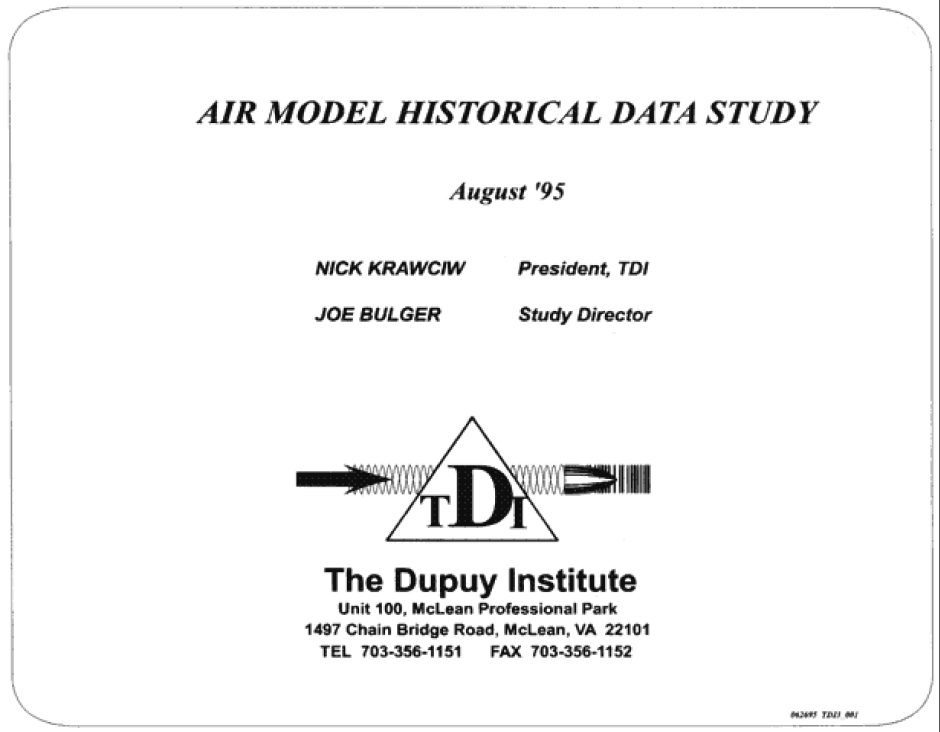
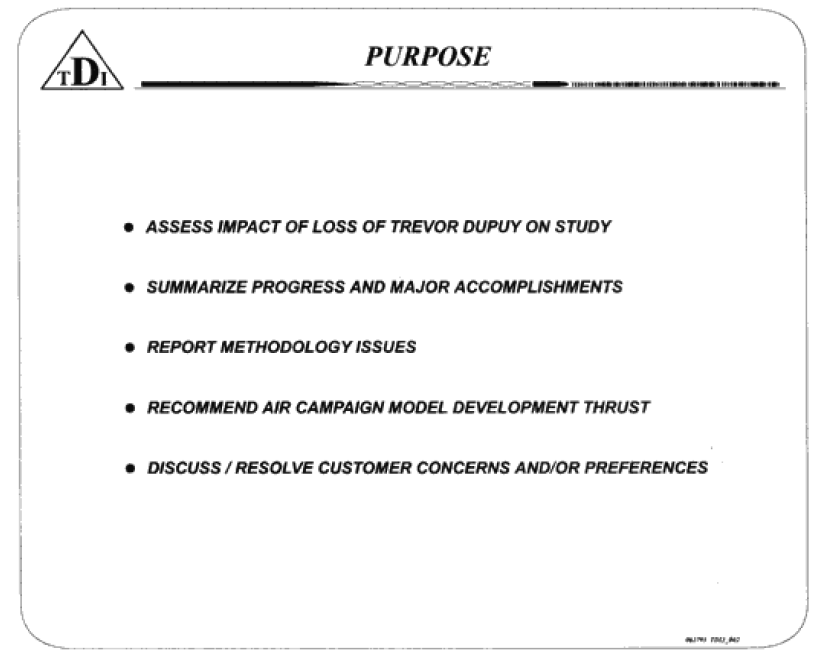
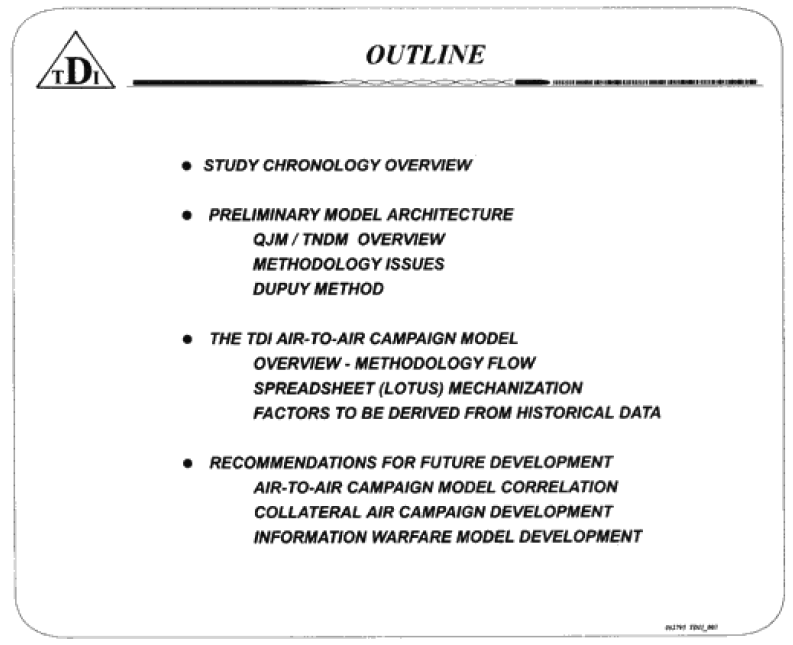
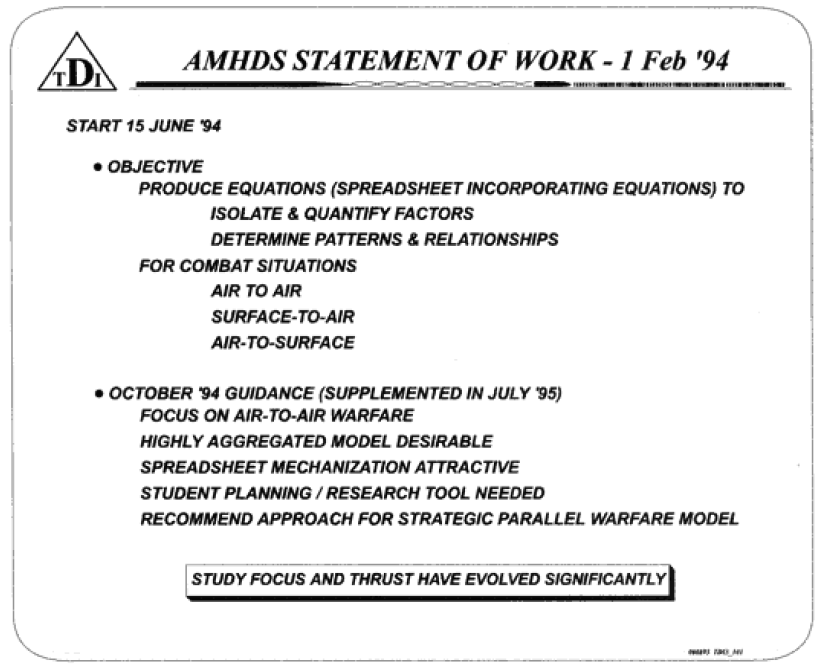
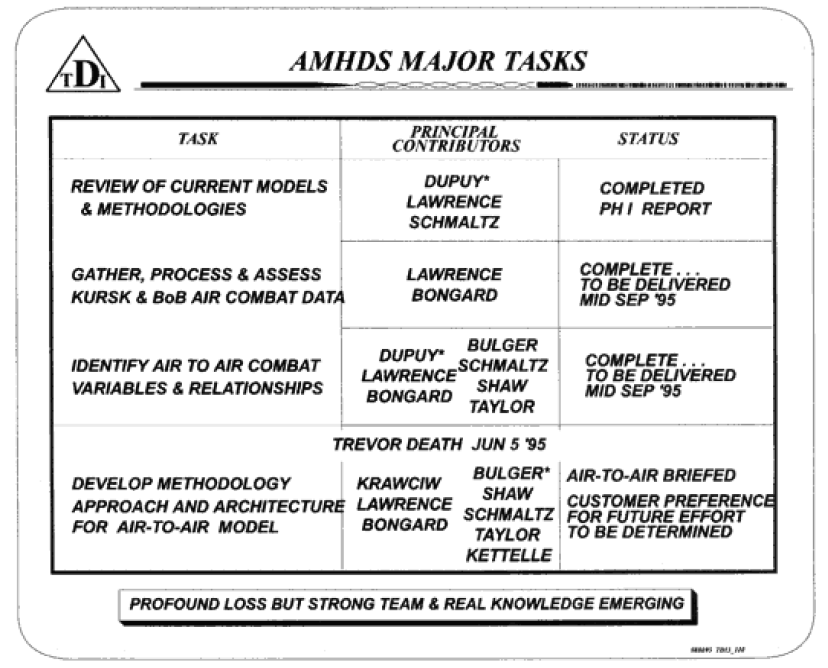



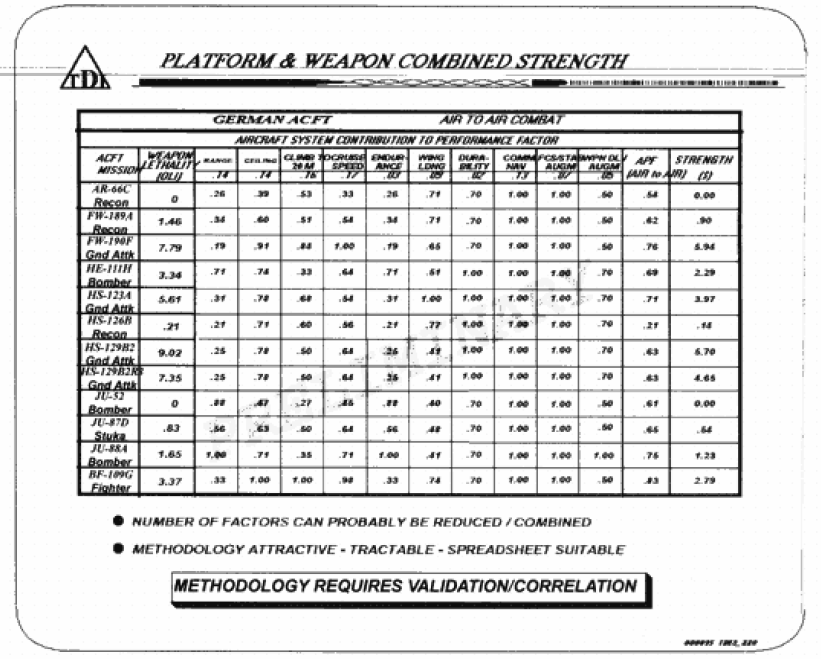




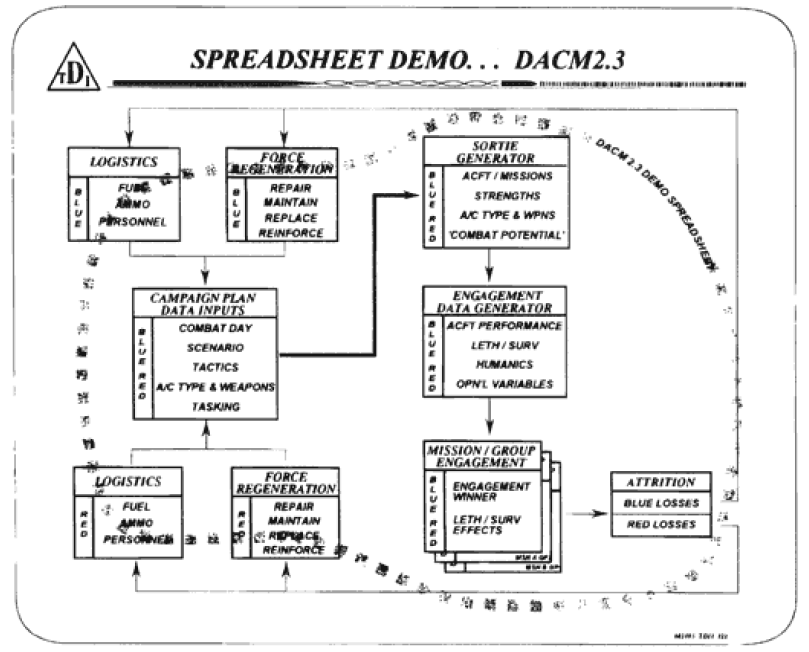
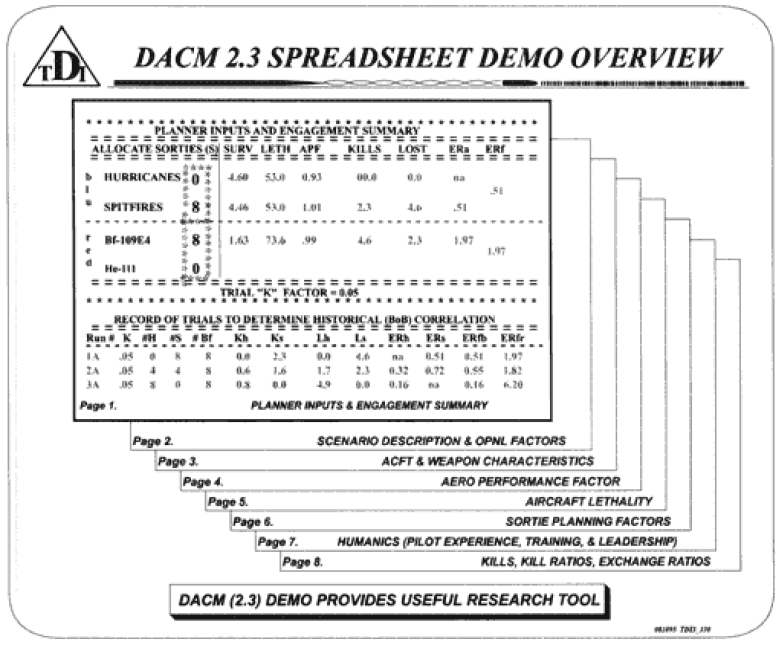

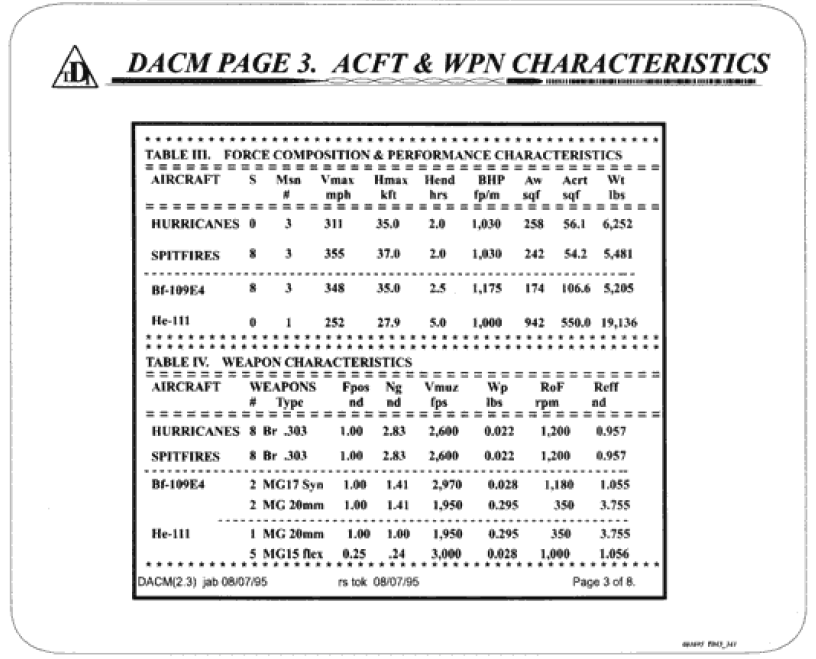

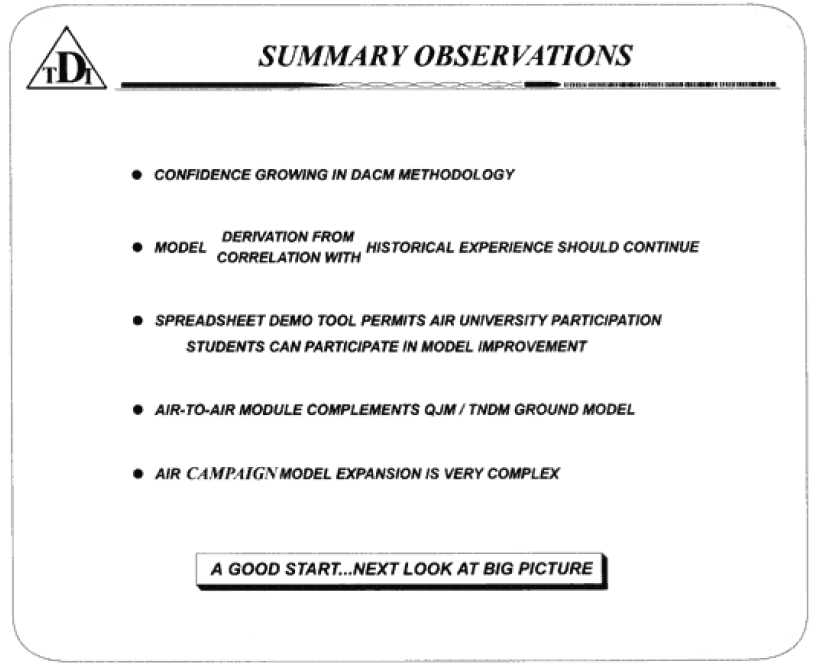

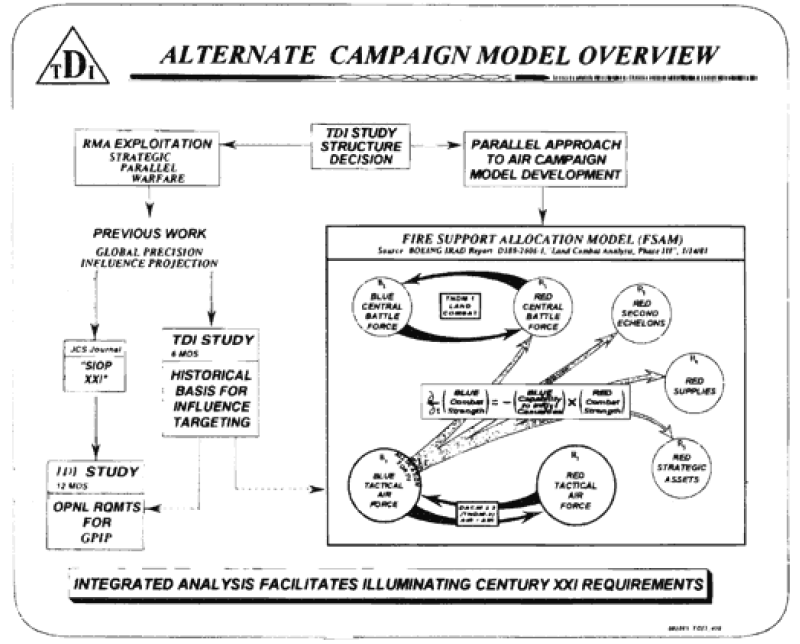




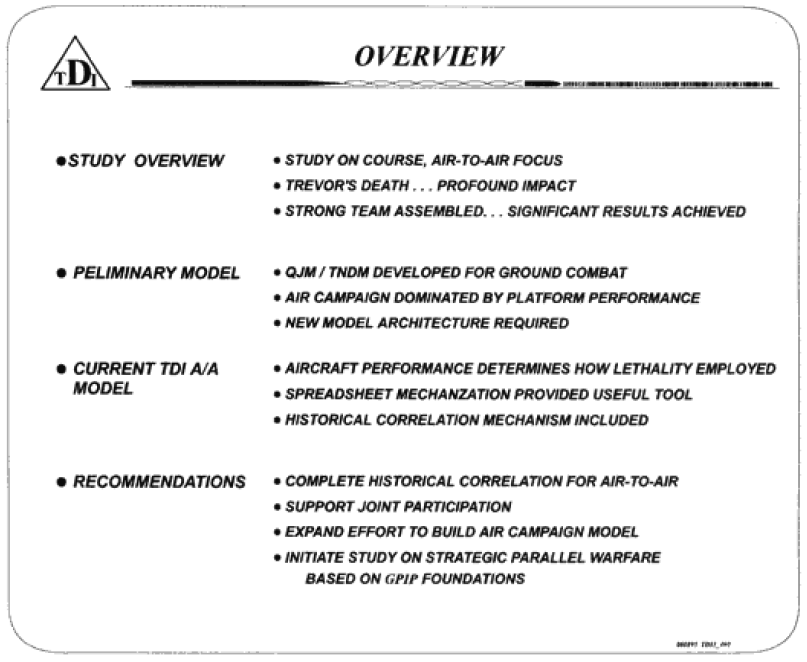

Coming from Europe, I am not familiar with the Dupuy Institute, however having read the above article and the webpage of the institute, I was wondering if you ever thought of applying Multiple Criteria Models (like AHP, PROMETHEE, ELECTRE, etc) in your research. Having worked on this OR field for many years, I believe they could be successfully applied on historical data.
No, we have not. Primarily because the nature of the problems we are looking at are more complex. When OR began to address combat, it found itself struggling to address more than a subset of the problem. What we are doing is really quantitative analysis of history, which in many respects has more in common with econometrics than it does with OR, even though most of combat models and our contract work has been with the military OR community.
Thank you for the reply; I can understand your reasoning. However, having read the excellent book “Fighting Power: German and U.S. Army Performance, 1939-1945” by Martin van Creveld, I have always being intrigued by the possibility to quantifiably access the performances of armies and produce a ranking from best to worst. This is not a trivial task without risks; it all comes to defining the right multiple criteria model of course, and not everything can be accurately (or without subjectivity) measured. What could, I think, be done is measure the perception professionals have (historians, military officers, etc) about the efficiency of armies, let’s say in WW2. I am thinking of performing such an exercise using fuzzy multiple criteria methods (thus creating a questionnaire to be distributed with linguistic variables) in Greece and/or Europe if possible. The aggregated results could be of interest and to my knowledge it has not been atempted in the past; I would love to have your views on that.
I choose to give a rather extended response to your question and it is posted as a blog post called “Response 2” (as this is the second time I have done this in response to someone’s questions).